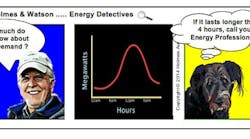Watson: I got a call from a salesman selling a Demand Response (DMR) System last week. He told me that a lot of electric utility companies are paying incentives to industrial plants to shut off non-critical equipment during periods of high peak demand and we should consider recommending his system to our clients. What do you think Holmes?
Holmes: How much do you know about Peak Demand and Demand Response, Watson?
Watson: I knew you would ask so I have already done a little research.
Peak Demand is used to refer to a historically high point in the sales record of a particular product. In terms of energy use, Peak Demand describes a period of highest demand in a billing period.
Demand Response is defined as “actions voluntarily taken by a consumer to adjust the amount or timing of his energy consumption”. Actions are generally in response to an economic signal (e.g. energy price, or government and/or utility incentive).
Holmes: Very good. Did you look at the literature he emailed us? How does his system work?
Watson: It includes both hardware and software. When it receives a signal from the utility company to limit the plant’s peak demand, switches that have been added to the plant’s electrical system shut off equipment that has been previously identified as non-critical.
What do you think of that approach, Holmes?
Holmes: You are probably anticipating what I am going to say. You know by now that when most people in this field agree on something, I don’t. I don’t make up my mind based on popular opinion; I base my beliefs on valid science and experience.
Watson: What’s the problem with Demand Response?
Holmes: It is a reactive approach and I disagree with reactive methods. We have always used a proactive approach. Our Energy Monitoring System continuously monitors the utility meters as well as the main electrical feeders and all of the major energy consuming systems. The reports show how the demand varies every minute of every day and where the peaks come from within the plant.
By using the resulting data to identify all of the contributors to the demand the owner can schedule and manage the loads to prevent those peaks from every occurring. There is no need to disrupt any systems in the middle of a production day to limit demand charges.
Our experience is that that same data exposes equipment that is running when it shouldn’t be and loads within the plant that are higher than normal which present other opportunities to reduce utility costs.
Watson: That makes perfect sense. I will give him a call and explain why we are not interested in recommending his system.
Holmes: What did the salesman say after you called him?
Watson: It was pretty obvious that he didn’t have much actual field experience. He was just parroting the company line. I do give him credit, though. After he thought about what I had told him for a minute, he said that maybe we wouldn’t be a very good match; it didn’t sound like our clients would have a need for his system.
Have you worked with any utility company peak demand incentive programs Holmes?
Holmes: Yes. We always look at utility programs and rates to help our clients reduce costs.
Watson: Can you give me some examples of things you have done to reduce peak demand charges?
Holmes: I can think of a number. Peak Demand Management normally has no or very low costs and immediate paybacks.
The best one was a Cement Plant with a 30 MW load. They had two primary mills and they switched between them about every 10 days for maintenance purposes. They had no idea the changeover, which occurred during a few hour period, was driving their peak up more than 2,100 KW. They put the monitor for the Energy Monitoring System on the Operator’s desk and he used it to help him make the changeover without exceeding the month’s peak demand target. I think that alone saved more than $30,000 a month.
As a part of a Six Sigma project in an Automotive Plant, data from our system was used to justify moving one operation from 1st to 3rd shift.
In an Ice Arena, limiting how many refrigeration compressors could run at one time cut the peak demand by 50%
We found that the Peak Demand could vary by 23% simply based on coincidental loads in an 80 MW G.E. plant, by 30% in a Grocery Store and on and on.
Watson: So if you proactively monitor and manage your loads, there is no need for a reactive Demand Response System?
Holmes: I advocate alarms to warn the owner if something has gone wrong and they are approaching the peak, but I would say that in 99% of the facilities I have seen, you are correct.
I would recommend that you read David McDougall’s 2013 Article in Sustainable Plant, The Top Five Energy Efficiency Measures for Industrial Businesses which has a very nice explanation of Peak Demand identification and Management.
Tell us about your experiences, both good and bad with energy professionals, what has worked and what hasn’t. Send us your comments, thoughts and suggestions on how to improve our profession so we can all continue to learn from each other. Thanks – Holmes & Watson
